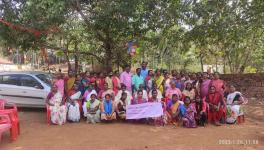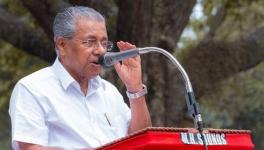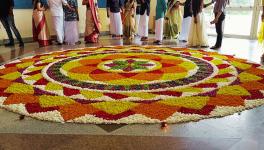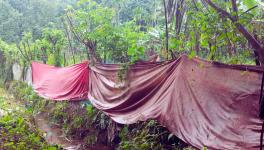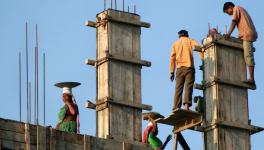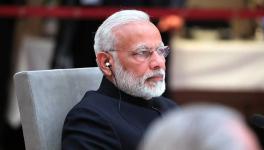Ageing Kerala Moves to Prioritise Care for Older Population
"The state shall, within the limits of its economic capacity and development, make effective provision for securing the right to work, to education and to public assistance in cases of unemployment, old age, sickness and disablement, and in other cases of undeserved want," states Article 41 of the Constitution of India.
Adopted on November 23, 1948, this article made it the state's duty to ensure the well-being of the elderly, or 'senior citizens'. Even as India, as a whole, experiences growth in the number and proportion of older people due to increasing life expectancy and decreasing fertility levels, the shift is markedly drastic in Kerala, the state which leads the country in these respects.
Last month, on the occasion of the International Day of Older Persons, Kerala was awarded the Vayoshreshtha Samman instituted by the Union Ministry of Social Justice and Empowerment, recognition for its excellence in implementing the Maintenance and Welfare of Parents and Senior Citizens Act, 2007, and providing services and facilities to senior citizens.
Kerala has led the country in implementing various provisions of the act and has the best security programme for the elderly. 'The state has a high population of senior citizens, and the award is a boost for the state and its efforts,' a press release issued by the Kerala government noted.
With India's elderly population projected to increase by 41% over the next decade, accounting for up to a fifth of the total population in the country by 2050, Kerala's progress in putting in place measures to prioritise the well-being of its older people will act as a guide for the design of policies in other states.
Demographic Transition in Kerala
The changing demographic patterns are not a phenomenon that is exclusive to Kerala or India. Worldwide, rising life expectancy and declining fertility rates have resulted in an increase in the older population.
According to the United Nations Population Projections, the number of older persons (60 years or over) is expected to double over the next three decades. The number of persons aged 80 years or above is expected to triple during the same period. In India, the share of the older population, which was 5.5% of the total population in 1950 and 8.6% in 2011, is expected to reach 19.5% by 2050. The share of those above 75 years in India (just 0.9% of the total population in 1950) is expected to increase from 1.7% in 2011 to 5.2% by 2050.
The 'Population Projections for India and States 2011-2036' Report prepared by the Technical Group on Population Projections of the National Commission on Population under the Union Ministry of Health and Family Welfare projects that the life expectancy at birth in India will increase from 66.9 years to 71.2 years for males and from 70.0 to 74.7 for females between 2011 and 2036.
In Kerala, where life expectancy at birth is already above the projected 2036 figures for the country, the corresponding figures for 2036 are 74.5 for males and 80.2 for females. The report explains the reasons for this – lower mortality and fertility rates were achieved in Kerala much earlier than in the rest of the country.
According to the latest Sample Registration System (SRS) Bulletin, Kerala's Infant Mortality Rate, defined as the number of deaths/1000 live births of children under one, stands at 6, against a national average of 30. The figure is comparable to high-income and upper-middle-income countries such as the United States and China.
The state also reached the replacement level of fertility (the level of fertility at which a population exactly replaces itself from one generation to the next) of 2.1 children/woman over three decades ago. Currently, Kerala's Total Fertility Rate (TFR) of 1.6 is much lower than the national average of 2.2.
These achievements, which point to the enormous advancements that Kerala has made in ensuring access to quality health care for its people, also mean that the proportion of older people in Kerala is much higher than in any other state. Kerala's old age population, which in 1961 was just 5.1% of its total population (lower than the national average of 5.6%), rose to 12.7% (national average 8.6%) by 2011. It is now estimated to be around 16.7%, as against a national average of 10.1%.
This proportion is further estimated to rise to 22.8% by 2036. In contrast, in Uttar Pradesh and Bihar, where the proportion of old age population was 7.4% and 6.3%, in 2011, the estimated proportion for 2036 is 11.8% and 10.9%, respectively.
Moreover, Kerala's old-age dependency ratio, defined as the number of old people per 100 working population (15-59 years), is currently at 26.1%, against a national average of 15.7%. In another decade, this is estimated to increase to 34.3% (national average 20.1%).
According to Kerala Economic Review 2017, the fastest-growing group among the old-age population in the state is those aged 80 years or above. This means that the 'demographic dividend', or the economic advantage enjoyed due to a large share of working-age people in the population, is on the wane in Kerala much earlier than in the rest of the country, and there is a simultaneous need to reorient the priorities of the state.
Prioritising the Older Population
Kerala marked the International Day of Older Persons by launching e-Sevanam, an official service portal and mobile app that integrates 509 government services, including social security and bill payments. The state government also removed many hassles, including charges for the issue of certificates and the need to visit government offices multiple times to get the same certificate issued.
The government also announced that senior citizens, those with physical or mental disabilities, bed-ridden patients, etc., will receive government services at their doorstep with the help of ASHA workers, Kudumbashree members and Samoohika Sannadha Sena network of volunteers. This initiative, called Vathilpadi Sevanam, was started during the government's 100-day programme.
The ruling Left Democratic Front (LDF) government has also expanded the social security net as its population ages. The monthly social security pension for old-aged persons, unmarried women above 50 years, widows and disabled people in Kerala has been hiked from Rs 600 to Rs 1600 in the last five years.
Similarly, the monthly pension for workers registered with the 16 welfare boards under the labour department, including agricultural labourers, small plantation workers and workers in allied areas, was also increased to Rs 1600. According to numbers released by the Kerala State Planning Board, more than one crore workers in the state are now eligible for benefits such as pension through the welfare boards and welfare fund boards, and around 30% of social security pensioners received a pension for the first time in the last five years.
An ageing population also means a resultant growth in old-age people who suffer from life-limiting severe illnesses or are terminally ill. This is where the state's widely lauded community-based palliative care system has been an advantage. The Neighbourhood Network in Palliative Care was set up in Kerala in 1999, developing an approach that emphasised local, community-based care.
This unique model of palliative care has utilised a decentralised network comprising thousands of volunteers across the state to deliver long-term and palliative care that also pays attention to the social and emotional well-being of both patients and caregivers.
Kerala now has over 1500 palliative care units primarily providing home-based care, many of them run by community-based and non-governmental organisations. This approach is being replicated in other parts of the country and even abroad.
Kerala, the first state to declare a comprehensive Palliative Care Policy in 2008, revised this policy in December 2019 and set up a palliative care grid at the state level that includes all the systems that provide palliative care in the state. The policy has aided the integration of community-based palliative care with the three-tier healthcare system in the state.
Palliative Care Divisions have been set up in all District and General Hospitals, and training is now given to community organisations and volunteers to provide home-based care. The rights-based approach of the policy is expected to expand access to palliative care. Around 26% of those in need of palliative care are estimated to have access to it in Kerala. The national average is 2%.
The state has also used its strong local government institutions to provide treatment for people in old-age homes through the Vayo Amrutham scheme and day-care facilities through the Sayamprabha Home project. The Karunya At Home project undertakes provisions of subsidised medicines at the doorsteps of senior citizens with the assistance of Kerala Medical Services Corporation Ltd.
During the COVID-19 pandemic, the Vayokshema Call Centre had also been started in the state to address the health-related and other needs of the elderly, along with the expansion of e-Sanjeevani telemedicine services.
Challenges Ahead
While the established social security net and decentralised governance system is an advantage for Kerala, its healthcare system will have to be adapted to the needs of the elderly.
The Longitudinal Ageing Study of India (LASI) Wave-1 India Report released by the Union Ministry of Health and Family Welfare estimates that 75% of the elderly in India suffer from at least one chronic disease. According to the report, Kerala is among the states having the highest self-reported prevalence of diagnosed cardiovascular diseases, chronic lung diseases and multi-morbidity conditions among those aged 60 years or above.
The State Old Age Policy, revised in 2013, notes the need for enhanced preventive health services. Kerala has now taken steps in this direction, with Health Minister Veena George announcing recently that the state would prepare a database of lifestyle diseases by surveying everyone aged 30 and above.
Through the Amrutham Aarogyam programme, clinics for diagnosis of lifestyle diseases operate in Family Health Centres in the state and screen those aged 30 and above. Treatment, including the provision for life-saving insulin injections, are given free of cost through these clinics. The Social Justice Department is also implementing the Vayomadhuram scheme, through which glucometers are being provided free to elderly diabetic persons from the Below Poverty Line (BPL) category.
While the Vayoshreshtha Samman is recognition for Kerala's progress in providing safety and security to the older population, the Kerala Development Report published by the State Planning Board delivers a word of caution. Even though the state has the highest number of registered old-age homes in the country, the report highlights many private unregistered and paid homes where cheating and even abuse of old-age people have been reported.
Reorienting state policies to address population ageing also means expanding opportunities for the older population to contribute to society and continue learning.
While the LDF Manifesto for the state assembly elections earlier this year had promised the setting up of senior citizen clubs under the supervision of Kudumbashree units, progress on this front has been delayed due to the COVID-19 pandemic.
Minister for Social Justice R Bindu recently announced Kerala's plans to tap senior citizens' services in various fields. But perhaps the most cheerful news recently was that of Kuttiyamma, a 104-year-old native of Ayarkunnam panchayat in Kottayam district, who scored 89 marks out of 100 and passed the basic literacy examination conducted by the Kerala State Literacy Mission; showing that old-age can be fulfilling given the right support.
Get the latest reports & analysis with people's perspective on Protests, movements & deep analytical videos, discussions of the current affairs in your Telegram app. Subscribe to NewsClick's Telegram channel & get Real-Time updates on stories, as they get published on our website.









